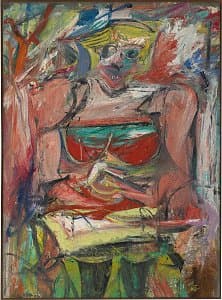

Willem de Kooning
Learn moreWoman V 1952-53
© The Willem de Kooning Foundation, New York. ARS/Copyright Agency Purchased 1974
More detail | PermalinkWillem de Kooning’s first paintings of female figures were made in 1940, some of them inspired by Elaine Fried, who he would later marry.[1] These early works show the contorted poses, folded limbs, clasped hands and, occasionally, exaggerated eyes, mouths and breasts later adopted for his extended series, but are generally more serene, both in paint-handling and in overall mood. Woman V, produced a decade later, personifies the artist’s energy, enthusiasm and, at times, fury for his subject: it seems to encapsulate his comment that flesh is the reason oil paint was invented.[2]
Woman V is the fifth in a series of six paintings depicting three-quarter‑length female figures, either seated or standing, made between 1950 and 1953. The first, Woman I, was begun in June 1950, and repeatedly changed and overpainted by de Kooning, until he abandoned the work in January or February 1952.[3] When art historian Meyer Schapiro saw the painting in the studio, and encouraged the artist to persist, de Kooning’s response was to begin three others: Woman II, Woman III and Woman IV.[4] By the end of June 1952, or perhaps as late as November, with four canvases near completion, de Kooning began Woman V and Woman VI in the autumn and winter of 1952, respectively.[5] The group of six works, exhibited at the Sidney Janis Gallery in March 1953, caused consternation among many artists and critics who felt that de Kooning had betrayed the ideals of abstraction.
Woman V, as John Elderfield observes, takes further the use of bright colour of the earlier works and the dense concentration of paint into rectangular form: it is as if the painting advances and realises the ambitions of the previous women.[6] Because de Kooning anchors the figure to the bottom edge of his composition, all but filling the canvas, the painting’s energy seems compressed. The figure’s square shoulders, her breasts enclosed by her arms, tiny dress and stockinged legs, as well as the agitation of her surroundings, encourage the eye to move around the composition, ‘picking up marginal incident along the way—bodily curves that bend to and from the edges of the canvas; the short, exposed parts of the legs, and the blurry head; and indications of landscape around these features at top and at bottom’.[7]
Various influences for this series have been suggested, both by the artist and several critics, from the Mesopotamian figurines on display at New York’s Metropolitan Museum of Art, to the grinning mouths of ‘pin-up’ girls, images of which de Kooning often cut from magazines and attached to his work.[8] Because Woman V, like the figures of Woman IV and Woman VI, appears to be standing in water Thomas B Hess has proposed a further influence: Rembrandt’s A woman bathing in a stream 1654.[9] Indeed, while working on the Woman series de Kooning commented that the paintings ‘reminded me very much of my childhood being in Holland, near all that water’.[10] Although the hands of Woman V are now clasped together at the waist, they were once arranged at each side in a gesture resembling that of Rembrandt’s painting, where the wading figure holds up her skirt to clear the water.
Lucina Ward
[1] See, for example, Seated woman c#1940, Philadelphia Museum of Art, and later works such as Queen of hearts 1943–46, Hirschhorn Museum and Sculpture Garden, Washington DC.
[2] Marcia Brennan, Modernism’s masculine subjects: Matisse, the New York School, and Post-Painterly Abstraction, MIT Press, Cambridge, 2004, p 72.
[3] The Museum of Modern Art, New York. Rudolph Burckhardt’s and Walter Auerbach’s photographs of Woman I in progress are often reproduced; see, for example, Paul Cummings, Jörn Merkert and Claire Stoullig, Willem de Kooning: Drawings, paintings, sculpture, Whitney Museum of American Art, New York 1983, p 176 and John Elderfield et al, De Kooning: A retrospective, Museum of Modern Art, New York, 2011, p 248.
[4] Woman II 1952 is also at the Museum of Modern Art, New York; Woman III 1952–53, now owned by David Geffen, Los Angeles, was previously part of the collection at the Tehran Museum of Contemporary Art; Woman IV is at the Nelson Gallery–Atkins Museum, Kansas City. De Kooning further explored the theme in an extensive series of drawings and pastels during the summer of 1952.
[5] Carnegie Museum of Art, Pittsburgh. For more detail, see also Michael Lloyd and Michael Desmond, European and American Paintings and Sculptures 1870–1970 in the Australian National Gallery, Australian National Gallery, Canberra, 1992, pp 258–9.
[6] Elderfield et al, p 274.
[7] As above.
[8] Sally Yard, ‘Willem de Kooning’s Women’, in Arts Magazine, vol 53, no 3, November 1978, pp 96–101.
[9] National Gallery, London; although de Kooning had not seen Rembrandt’s painting in the flesh, it was widely reproduced, including in an Artnews article in February 1952 about the cleaning of Old Master paintings. Thomas B Hess, ‘Four pictures by de Kooning at Canberra’, Art and Australia, vol 14, nos 3 & 4, January–April 1977, pp 289–96.
[10] Harold Rosenberg, ‘Interview with Willem de Kooning’, Artnews, vol 71, no 5, September 1972, p 57.

